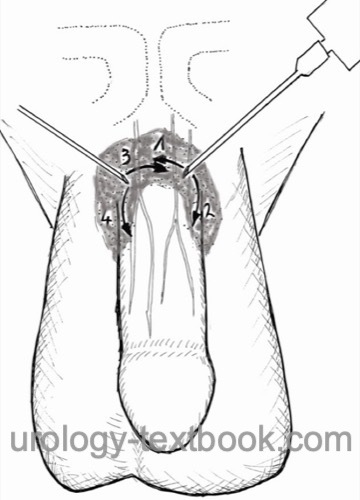You are here: Urology Textbook > Surgery (procedures) > Penile nerve block
Penile Nerve Block: Technique, Dosage and Complications
Indications for a Dorsal Penile Nerve Block
The penile nerve block is an effective regional anesthesia of the penile shaft skin and glans penis. It enables, among others, the following operations: circumcision, dorsal incision for paraphimosis, biopsy of a penile tumor, or treatment of priapism. Furthermore, the penile nerve block is effective for postoperative analgesia after penile surgery under general anesthesia.
Contraindications
- Contraindications against local anesthetic agents.
- Skin infections at the injection site.
- Patients who are unsuitable for procedures under local anesthesia (e.g., children, patients with phobia).
Technique of the Dorsal Penile Nerve Block
Distal Ring Block:
The technique is mainly used for adults. Disinfection of the external genitalia. Grasp the penis at the coronal sulcus and stretch in length. Inject 12–20 ml of local anesthetic subcutaneously as a ring block around the base of the penile shaft using two injection sites. See the section pharmacology of local anesthetics for side effects and contraindications. The needle should be passed as close as possible to the corpus cavernosum to inject the anesthetic agent under the Buck fascia. Be careful not to injure larger vessels near the dorsal midline or to enter the corpus cavernosum. After injection, compress the penile shaft proximally to the anesthetic depot with an unfolded gauze (like a tourniquet). The compression hinders resorption and leads to better diffusion into deep layers. Wait at least for 10 min before starting the procedure.
Local Anesthetics with Adrenaline:
Local anesthetics with adrenaline significantly reduce bleeding, prolong the duration, and reduce the side effects of local anesthesia. Historically and also in the drug approvals, the use in areas with end arteries (such as the penis) is contraindicated. In current medical practice, however, local anesthetics with adrenaline are regularly used (off-label) for surgery on fingers (Prabhakar et al., 2015). Since the penile blood flow is even less problematic due to additional cavernous vessels, the use of local anesthetics with adrenaline is possible for penile surgery (Schnabl et al., 2014) (Alizadeh et al., 2016).
 |
Subpubic Dorsal Penile Nerve Block:
The technique is mainly used for children. Disinfection of the external genitalia. Grasp the penis at the coronal sulcus and stretch in a caudal direction. Inject a small volume subcutaneously at the midline between the symphysis and penile shaft. Advance the needle to the pubis to gauge the depth. Retract the needle slightly and redirect it to enter the subpubic space lateral of the suspensory ligament and under the fascia. Aspirate and inject the calculated volume (for children 1 ml + 0.1 ml/kg, maximum 6 ml for each side). Adjust the dilution of the local anesthetic to the injection volume. Repeat the procedure for the contralateral subpubic space. Additional distal local anesthesia may be necessary for procedures near the frenulum.
 |
Complications:
Insufficient anesthesia, bleeding, hematoma, intravascular injection with side effects of the local anesthetic.
| Principles of hypospadias operations | Index | Circumcision |
Index: 1–9 A B C D E F G H I J K L M N O P Q R S T U V W X Y Z
References
Alizadeh F, Fakoor A, Haghdani S. A comparison between tourniquet application and epinephrine injection for hemostasis during hypospadias surgery: The effect on bleeding and postoperative outcome. J Pediatr Urol. 2016 Jun;12(3):160.e1-5. doi: 10.1016/j.jpurol.2016.02.005.
Prabhakar H, Rath S, Kalaivani M, Bhanderi N. Adrenaline with lidocaine for digital nerve blocks. Cochrane Database Syst Rev. 2015 Mar 19;2015(3):CD010645. doi: 10.1002/14651858.CD010645.pub2.
Schnabl SM, Ghoreschi FC, Scheu A, Kofler L, Häfner HM, Breuninger H. Use of local anesthetics with an epinephrine additive on fingers and penis - dogma and reality. J Dtsch Dermatol Ges. 2021 Feb;19(2):185-196. doi: 10.1111/ddg.14434. PMID: 33586877.
 Deutsche Version: Technik, Dosierung und Komplikationen des Peniswurzelblock
Deutsche Version: Technik, Dosierung und Komplikationen des Peniswurzelblock
Urology-Textbook.com – Choose the Ad-Free, Professional Resource
This website is designed for physicians and medical professionals. It presents diseases of the genital organs through detailed text and images. Some content may not be suitable for children or sensitive readers. Many illustrations are available exclusively to Steady members. Are you a physician and interested in supporting this project? Join Steady to unlock full access to all images and enjoy an ad-free experience. Try it free for 7 days—no obligation.
New release: The first edition of the Urology Textbook as an e-book—ideal for offline reading and quick reference. With over 1300 pages and hundreds of illustrations, it’s the perfect companion for residents and medical students. After your 7-day trial has ended, you will receive a download link for your exclusive e-book.